Exploration of Carbon Emission Reduction Pathways for Urban Residential Buildings at the Provincial Level: A Case Study of Jiangsu Province
Abstract
1. Introduction
2. Method
2.1. Methodology Overview
2.2. Study Area and Data Sources
2.2.1. Study Area
2.2.2. Data Sources
2.3. Spatial Autocorrelation Analysis
2.4. Factor Decomposition Analysis
2.4.1. Kaya Identity Framework
2.4.2. LMDI Decomposition Method
2.5. System Dynamics Model
2.5.1. Overview of System Dynamics Methodology
2.5.2. Causal Loop Diagram
2.5.3. Stock and Flow Diagram
2.5.4. Scenario Design and Policy Simulation
2.6. Tapio Decoupling Model
3. Results
3.1. Spatial-Temporal Distribution of Residential Building Carbon Emissions
3.1.1. Temporal Evolution and Spatial Patterns
3.1.2. Spatial Autocorrelation Findings
3.2. LMDI Decomposition Results Analysis
3.2.1. Cross-Regional Comparative Analysis
3.2.2. Southern Jiangsu: Advanced Development with Energy Transition
3.2.3. Central Jiangsu: Transitional Development with Structural Challenges
3.2.4. Northern Jiangsu: Resource Constraints with Renewable Energy Potential
3.3. Scenario Analysis and Future Projections
3.3.1. Projection Results and Regional Analysis
3.3.2. Policy Pathway Analysis and Strategic Implications
3.4. Decoupling Analysis
4. Discussion
4.1. Methodological Innovation and Regional Heterogeneity Insights
4.2. Policy Effectiveness and Decoupling Pathways
4.3. Limitations and Future Research Directions
5. Conclusions
Author Contributions
Funding
Data Availability Statement
Conflicts of Interest
Appendix A. Detailed LMDI Decomposition Formulas
Appendix B. Statistical Table of Related Factors in the SD Model
| Subsystem | Influencing Factor | Definition |
| Economic | GDP | Gross Domestic Product |
| Per capita GDP | Per capita Gross Domestic Product | |
| Value added of secondary industry | Value added by secondary industry in production of final products and services during a specific period | |
| Per capita consumption expenditure of urban residents | Total expenditure of urban resident households for daily life per capita | |
| Per capita disposable income of urban residents | Cash income available for household daily life arrangements after deducting necessary expenses | |
| Social | Population | Population residing in a region for more than six months |
| Urban population | Population residing in cities and towns | |
| Urbanization rate | Proportion of urban population to total population | |
| Urban residential area | General household residential area | |
| Energy | Total energy consumption | Total consumption of various energy sources in the region during a specific period |
| Per capita energy consumption | Average energy consumption per person | |
| Policy | Science and technology service investment | Investment supporting technological activities, also productive investment |
| Economic density | Ratio of regional GDP to regional area |
Appendix C. SD Model Validation
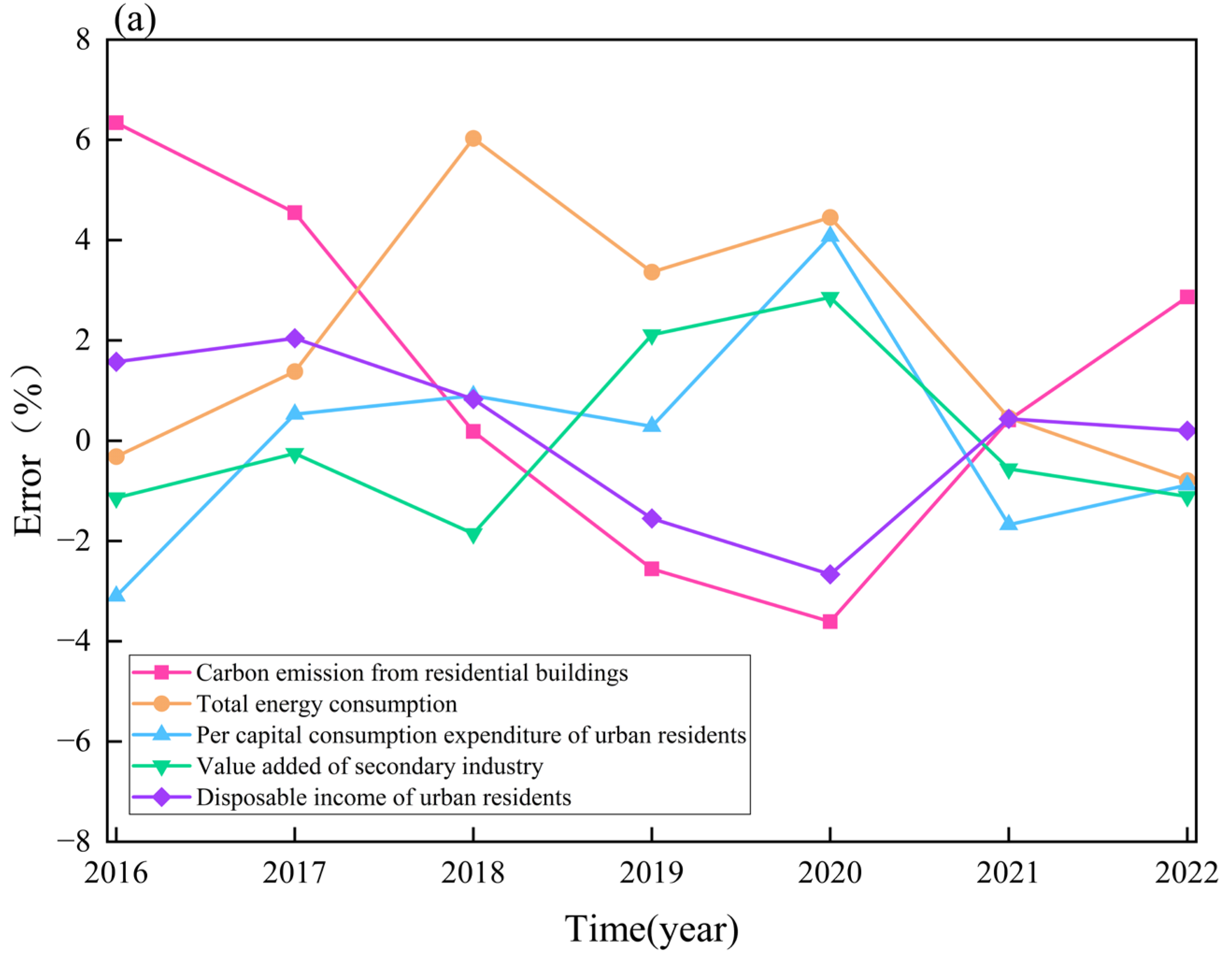

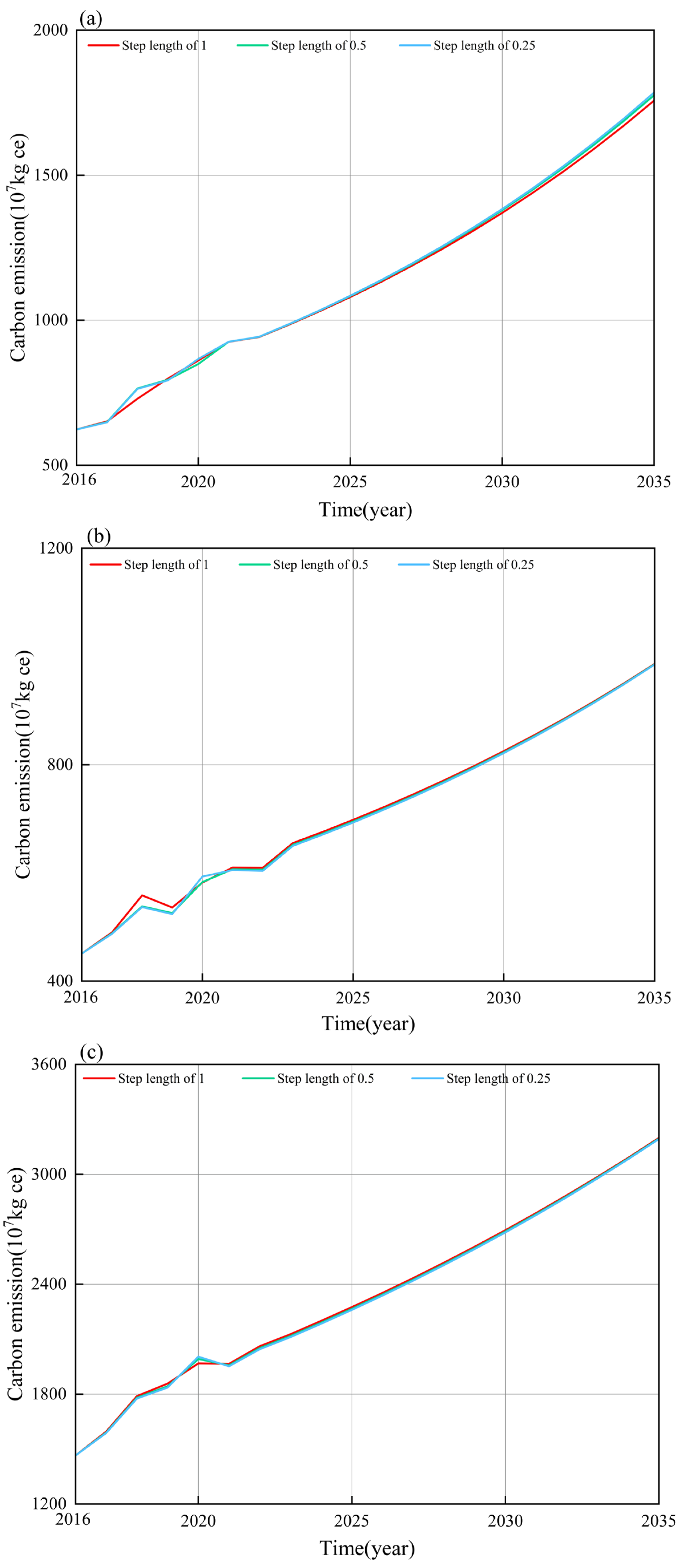
Appendix D. Parameter Settings of Key Variables for Four Scenarios Across Three Regions
| Region | Factor | Period | BS | LCS | EGS | CS |
| Southern Jiangsu | GDP growth rate (%) | 2026–2030 | 4 | 3.6 | 4.2 | 3.8 |
| 2031–2035 | 3.6 | 3 | 4 | 3.2 | ||
| Population increase rate (%) | 2026–2030 | 0.12 | −0.03 | 0.2 | 0.01 | |
| 2031–2035 | −0.09 | −0.17 | 0.13 | −0.02 | ||
| Urbanization rate (%) | 2026–2030 | 86 | 86.7 | 89 | 87 | |
| 2031–2035 | 87 | 89 | 92 | 90 | ||
| Scientific innovation input (×108 CNY) | 2026–2030 | 546 | 591 | 558 | 574 | |
| 2031–2035 | 571 | 656 | 590 | 615 | ||
| Central Jiangsu | GDP growth rate (%) | 2026–2030 | 4.6 | 4.2 | 4.8 | 4.4 |
| 2031–2035 | 4.35 | 3.5 | 4.6 | 4 | ||
| Population increase rate (%) | 2026–2030 | −0.04 | −0.11 | 0.01 | −0.06 | |
| 2031–2035 | −0.09 | −0.19 | −0.03 | −0.13 | ||
| Urbanization rate (%) | 2026–2030 | 74 | 75 | 78 | 76 | |
| 2031–2035 | 75 | 78 | 82 | 81 | ||
| Scientific innovation input (×108 CNY) | 2026–2030 | 112 | 125 | 116 | 122 | |
| 2031–2035 | 126 | 145 | 132 | 140 | ||
| Northern Jiangsu | GDP growth rate (%) | 2026–2030 | 6 | 5.5 | 6.2 | 5.7 |
| 2031–2035 | 5.5 | 4.6 | 5.7 | 5 | ||
| Population increase rate (%) | 2026–2030 | −0.12 | −0.2 | 0.03 | −0.11 | |
| 2031–2035 | −0.17 | −0.3 | −0.13 | −0.19 | ||
| Urbanization rate (%) | 2026–2030 | 69 | 71 | 75 | 73 | |
| 2031–2035 | 71 | 73 | 78 | 76 | ||
| Scientific innovation input (×108 CNY) | 2026–2030 | 116 | 127 | 119 | 123 | |
| 2031–2035 | 131 | 151 | 138 | 141 | ||
| All Regions | Electricity carbon emission factor | 2026–2030 | 0.6 | 0.55 | 0.61 | 0.57 |
| 2031–2035 | −0.01 | −0.04 | −0.005 | −0.02 |
References
- Rogelj, J.; den Elzen, M.; Höhne, N.; Fransen, T.; Fekete, H.; Winkler, H.; Schaeffer, R.; Sha, F.; Riahi, K.; Meinshausen, M. Paris Agreement climate proposals need a boost to keep warming well below 2 °C. Nature 2016, 534, 631–639. [Google Scholar] [CrossRef]
- Masson-Delmotte, V.; Zhai, P.; Pörtner, H.O.; Roberts, D.; Skea, J.; Shukla, P.R. Global Warming of 1.5 C: IPCC Special Report on Impacts of Global Warming of 1.5 C Above Pre-Industrial Levels in Context of Strengthening Response to Climate Change, Sustainable Development, and Efforts to Eradicate Poverty; Cambridge University Press: Cambridge, UK, 2022. [Google Scholar]
- Xu, D.; Li, J.; Sheng, C. Carbon Peaking and Carbon Neutrality in China: Theory and Practice; Springer Nature: Dordrecht, GX, The Netherlands, 2024. [Google Scholar]
- China association of building energy efficiency. Research Report on Carbon Emissions in China’s Urban and Rural Construction Sector (2024 Edition). 2024. Available online: http://www.xjaepi.org.cn/upload/portal/20250124/5af26b9d581063ad6c58594680ca30ae.pdf (accessed on 10 January 2025).
- Wang, X.; Duan, Z.; Wu, L.; Yang, D. Estimation of carbon dioxide emission in highway construction: A case study in southwest region of China. J. Clean. Prod. 2015, 103, 705–714. [Google Scholar] [CrossRef]
- Wang, J.; You, K.; Qi, L.; Ren, H. Gravity center change of carbon emissions in Chinese residential building sector: Differences between urban and rural area. Energy Rep. 2022, 8, 10644–10656. [Google Scholar] [CrossRef]
- Zhang, Z.; Mu, X.; Hu, G. Analysis of influencing factors of energy consumption in Beijing: Based on the IPAT model. Environ. Dev. Sustain. 2024, 26, 12569–12588. [Google Scholar] [CrossRef]
- Wang, Q.; Han, X.; Li, R. Does technical progress curb India’s carbon emissions? A novel approach of combining extended index decomposition analysis and production-theoretical decomposition analysis. J. Environ. Manag. 2022, 310, 114720. [Google Scholar] [CrossRef]
- Zhu, C.; Chang, Y.; Li, X.; Shan, M. Factors influencing embodied carbon emissions of China’s building sector: An analysis based on extended STIRPAT modeling. Energy Build. 2022, 255, 111607. [Google Scholar] [CrossRef]
- Lin, C.; Li, X. Carbon peak prediction and emission reduction pathways exploration for provincial residential buildings: Evidence from Fujian Province. Sustain. Cities Soc. 2024, 102, 105239. [Google Scholar] [CrossRef]
- Huo, T.; Ma, Y.; Yu, T.; Cai, W.; Liu, B.; Ren, H. Decoupling and decomposition analysis of residential building carbon emissions from residential income: Evidence from the provincial level in China. Environ. Impact Assess. Rev. 2021, 86, 106487. [Google Scholar] [CrossRef]
- Yang, X.; Sima, Y.; Lv, Y.; Li, M. Research on influencing factors of residential building carbon emissions and Carbon Peak: A case of Henan Province in China. Sustainability 2023, 15, 10243. [Google Scholar] [CrossRef]
- Ke, Y.; Zhou, L.; Zhu, M.; Yang, Y.; Fan, R.; Ma, X. Scenario prediction of carbon emission peak of urban residential buildings in China’s coastal region: A case of Fujian province. Sustainability 2023, 15, 2456. [Google Scholar] [CrossRef]
- Li, W.; Li, Q.; Zhang, C.; Jin, S.; Wang, Z.; Huang, S.; Deng, S. The Quantification of Carbon Emission Factors for Residential buildings in Yunnan Province. Buildings 2024, 14, 880. [Google Scholar] [CrossRef]
- Jia, T.; Yang, S.; Li, X.; Yan, P.; Yu, X.; Luo, X.; Chen, K. Computation of carbon emissions of residential buildings in Wuhan and its spatiotemporal analysis. J. Geo-Inf. Sci. 2020, 22, 1063–1072. [Google Scholar]
- Huo, T.; Cao, R.; Du, H.; Zhang, J.; Cai, W.; Liu, B. Nonlinear influence of urbanization on China’s urban residential building carbon emissions: New evidence from panel threshold model. Sci. Total Environ. 2021, 772, 145058. [Google Scholar] [CrossRef] [PubMed]
- Huang, R.; Zhang, X.; Liu, K. Assessment of operational carbon emissions for residential buildings comparing different machine learning approaches: A study of 34 cities in China. Build. Environ. 2024, 250, 111176. [Google Scholar] [CrossRef]
- Ojaghlou, M.; Ugurlu, E.; Kadłubek, M.; Thalassinos, E. Economic activities and management issues for the environment: An environmental Kuznets curve (EKC) and STIRPAT analysis in Turkey. Resources 2023, 12, 57. [Google Scholar] [CrossRef]
- Rehman, E.; Rehman, S. Modeling the nexus between carbon emissions, urbanization, population growth, energy consumption, and economic development in Asia: Evidence from grey relational analysis. Energy Rep. 2022, 8, 5430–5442. [Google Scholar] [CrossRef]
- Xu, J.; Qian, Y.; He, B.; Xiang, H.; Ling, R.; Xu, G. Strategies for Mitigating Urban Residential Carbon Emissions: A System Dynamics Analysis of Kunming, China. Buildings 2024, 14, 982. [Google Scholar] [CrossRef]
- Song, T.; Zou, X.; Wang, N.; Zhang, D.; Zhao, Y.; Wang, E. Prediction of China’s Carbon Peak Attainment Pathway from Both Production-Side and Consumption-Side Perspectives. Sustainability 2023, 15, 4844. [Google Scholar] [CrossRef]
- Han, Y.; Cao, L.; Geng, Z.; Ping, W.; Zuo, X.; Fan, J.; Wan, J.; Lu, G. Novel economy and carbon emissions prediction model of different countries or regions in the world for energy optimization using improved residual neural network. Sci. Total Environ. 2023, 860, 160410. [Google Scholar] [CrossRef]
- Liu, X.; Wang, X.; Meng, X. Carbon emission scenario prediction and peak path selection in China. Energies 2023, 16, 2276. [Google Scholar] [CrossRef]
- Kazancoglu, Y.; Ekinci, E.; Mangla, S.K.; Sezer, M.D.; Kayikci, Y. Performance evaluation of reverse logistics in food supply chains in a circular economy using system dynamics. Bus. Strat. Environ. 2021, 30, 71–91. [Google Scholar] [CrossRef]
- Shepherd, S.P. A review of system dynamics models applied in transportation. Transp. B Transp. Dyn. 2014, 2, 83–105. [Google Scholar] [CrossRef]
- Fontes, C.H.D.O.; Freires, F.G.M. Sustainable and renewable energy supply chain: A system dynamics overview. Renew. Sustain. Energy Rev. 2018, 82, 247–259. [Google Scholar] [CrossRef]
- Riaz, H.; Khan, K.I.A.; Ullah, F.; Tahir, M.B.; Alqurashi, M.; Alsulami, B.T. Key factors for implementation of total quality management in construction Sector: A system dynamics approach. Ain Shams Eng. J. 2023, 14, 101903. [Google Scholar] [CrossRef]
- Miao, A.; Yuan, Y.; Wu, H.; Ma, X.; Shao, C.; Xiang, S. Pathway for China’s provincial carbon emission peak: A case study of the Jiangsu Province. Energy 2024, 298, 131417. [Google Scholar] [CrossRef]
- Deng, J.; Liu, C.; Mao, C. Carbon Emissions Drivers and Reduction Strategies in Jiangsu Province. Sustainability 2024, 16, 5276. [Google Scholar] [CrossRef]
- Jiangsu Provincial Government. Population and Administrative Divisions. 2025. Available online: https://www.jiangsu.gov.cn/col/col88749/index.html (accessed on 28 April 2025).
- Bureau of Statistics of Jiangsu Province. Interpretation of the Main Statistical Data on Jiangsu’s Economic and Social Development in 2024. 2025. Available online: https://www.js.gov.cn/art/2025/1/23/art_88350_11478583.html (accessed on 28 April 2025).
- National Bureau of Statistics of China. Statistical Communiqué of the People’s Republic of China on the 2024 National Economic and Social Development. 2025. Available online: https://www.gov.cn/lianbo/bumen/202502/content_7008605.htm (accessed on 28 April 2025).
- Province Bureau of Statistics of Jiangsu. Jiangsu Statistical Yearbook. 2025. Available online: https://www.jiangsu.gov.cn/col/col84736/ (accessed on 10 January 2025).
- Xiong, G.; Cao, X.; Hamm, N.A.S.; Lin, T.; Zhang, G.; Chen, B. Unbalanced development characteristics and driving mechanisms of regional urban spatial form: A case study of Jiangsu Province, China. Sustainability 2021, 13, 3121. [Google Scholar] [CrossRef]
- Jiangsu Provincial Department of Housing and Urban-Rural Development, Jiangsu Provincial Development and Reform Commission. Carbon Peak Implementation Plan for Urban and Rural Construction in Jiangsu Province. 2023. Available online: https://jsszfhcxjst.jiangsu.gov.cn/art/2023/1/18/art_8639_10729756.html (accessed on 10 January 2025).
- Jiangsu Provincial Department of Housing and Urban-Rural Development. Jiangsu’s 14th Five-Year Plan on Green Building High-Quality Development. 2021. Available online: https://jsszfhcxjst.jiangsu.gov.cn/art/2021/9/14/art_8639_10013660.html (accessed on 10 January 2025).
- Jiangsu Provincial Department of Housing and Urban-Rural Development. Jiangsu’s 14th Five-Year Plan for the Construction Industry. 2021. Available online: https://jsszfhcxjst.jiangsu.gov.cn/art/2021/7/23/art_8639_9897063.html (accessed on 10 January 2025).
- National Bureau of Statistics of China. China City Statistical Yearbook. 2023. Available online: https://www.stats.gov.cn/english/Statisticaldata/yearbook/ (accessed on 12 January 2025).
- Jiangsu Provincial Department of Industry and Information Technology. Jiangsu Province’s 13th Five-Year Energy Conservation Plan. 2016. Available online: https://gxt.jiangsu.gov.cn/art/2016/10/14/art_6299_3030340.html (accessed on 10 January 2025).
- Moran, P.A.P. Notes on continuous stochastic phenomena. Biometrika 1950, 37, 17–23. [Google Scholar] [CrossRef]
- Moraga, P. Spatial Statistics for Data Science: Theory and Practice with R; CRC Press: Boca Raton, FL, USA, 2023. [Google Scholar]
- Kaya, Y. Impact of Carbon Dioxide Emission Control on GNP Growth: Interpretation of Proposed Scenarios; Intergovernmental Panel on Climate Change/Response Strategies Working Group: Geneva, Switzerland, 1989. [Google Scholar]
- Li, R.; You, K.; Cai, W.; Wang, J.; Liu, Y.; Yu, Y. Will the southward center of gravity migration of population, floor area, and building energy consumption facilitate building carbon emission reduction in China? Build. Environ. 2023, 242, 110576. [Google Scholar] [CrossRef]
- Huo, T.; Li, X.; Cai, W.; Zuo, J.; Jia, F.; Wei, H. Exploring the impact of urbanization on urban building carbon emissions in China: Evidence from a provincial panel data model. Sustain. Cities Soc. 2020, 56, 102068. [Google Scholar] [CrossRef]
- Chen, Y.; Lin, S. Study on factors affecting energy-related per capita carbon dioxide emission by multi-sectoral of cities: A case study of Tianjin. Nat. Hazards 2015, 77, 833–846. [Google Scholar] [CrossRef]
- Meng, Z.; Wang, H.; Wang, B. Empirical analysis of carbon emission accounting and influencing factors of energy consumption in China. Int. J. Environ. Res. Public Health 2018, 15, 2467. [Google Scholar] [CrossRef]
- Wang, L.; Dai, S. Carbon Footprint Accounting and Verification of Seven Major Urban Agglomerations in China Based on Dynamic Emission Factor Model. Sustainability 2024, 16, 9817. [Google Scholar] [CrossRef]
- Zhang, Z.; Liu, Y.; Ma, T. Assessing spatiotemporal characteristics and driving factors of urban public buildings carbon emissions in China: An approach based on LMDI analysis. Atmosphere 2023, 14, 1280. [Google Scholar] [CrossRef]
- Ang, B.W. LMDI decomposition approach: A guide for implementation. Energy Policy 2015, 86, 233–238. [Google Scholar] [CrossRef]
- Jing, L.; Zhou, B.; Liao, Z. Decoupling Analysis of Economic Growth and Carbon Emissions in Xinjiang Based on Tapio and Logarithmic Mean Divisia Index Models. Sustainability 2024, 16, 8010. [Google Scholar] [CrossRef]
- Yin, Z.; Jiang, X.; Lin, S.; Liu, J. The impact of online education on carbon emissions in the context of the COVID-19 pandemic—Taking Chinese universities as examples. Appl. Energy 2022, 314, 118875. [Google Scholar] [CrossRef]
- Li, Z.; Qin, Y.; Zhang, L.; Li, T.; Wang, Q. Research on the development for emerging industries in Nan-tong under the national strategy. IOP Conf. Ser. Earth Environ. Sci. 2017, 81, 012108. [Google Scholar] [CrossRef]
- Li, D.; Huang, G.; Zhu, S.; Chen, L.; Wang, J. How to peak carbon emissions of provincial construction industry? Scenario analysis of Jiangsu Province. Renew. Sustain. Energy Rev. 2021, 144, 110953. [Google Scholar] [CrossRef]
- Ding, Y.; Xu, L.; Sun, Y.; Wu, Y.; Liu, X.; Geng, X. Large but overlooked carbon differentiations inside China’s provinces matters to mitigation strategies design: Evidence from county-level analysis. Sci. Total Environ. 2023, 898, 165551. [Google Scholar] [CrossRef]
- Lv, T.; Hu, H.; Zhang, X.; Xie, H.; Wang, L.; Fu, S. Spatial spillover effects of urbanization on carbon emissions in the Yangtze River Delta urban agglomeration, China. Environ. Sci. Pollut. Res. 2022, 29, 33920–33934. [Google Scholar] [CrossRef] [PubMed]
- Yang, T.; Pan, Y.; Yang, Y.; Lin, M.; Qin, B.; Xu, P.; Huang, Z. CO2 emissions in China’s building sector through 2050: A scenario analysis based on a bottom-up model. Energy 2017, 128, 208–223. [Google Scholar] [CrossRef]
- Duan, C.; Zhu, W.; Wang, S.; Chen, B. Drivers of global carbon emissions 1990–2014. J. Clean. Prod. 2022, 371, 133371. [Google Scholar] [CrossRef]
- Chen, H.; Du, Q.; Huo, T.; Liu, P.; Cai, W.; Liu, B. Spatiotemporal patterns and driving mechanism of carbon emissions in China’s urban residential building sector. Energy 2023, 263, 126102. [Google Scholar] [CrossRef]
- Porter, M.E.; Linde, C.V.D. Toward a new conception of the environment-competitiveness relationship. J. Econ. Perspect. 1995, 9, 97–118. [Google Scholar] [CrossRef]
- Liu, R.; Fang, Y.R.; Peng, S.; Benani, N.; Wu, X.; Chen, Y.; Wang, T.; Chai, Q.; Yang, P. Study on factors influencing carbon dioxide emissions and carbon peak heterogenous pathways in Chinese provinces. J. Environ. Manag. 2024, 365, 121667. [Google Scholar] [CrossRef]
- Wu, Y.; Tam, V.W.Y.; Shuai, C.; Shen, L.; Zhang, Y.; Liao, S. Decoupling China’s economic growth from carbon emissions: Empirical studies from 30 Chinese provinces (2001–2015). Sci. Total Environ. 2019, 656, 576–588. [Google Scholar] [CrossRef]
- Hermwille, L. Hardwired towards transformation? Assessing global climate governance for power sector decarbonization. Earth Syst. Gov. 2021, 8, 100054. [Google Scholar] [CrossRef]
- Yang, T.; Zhou, C.; Xiao, T.; Xu, Q. Coordinated Development of the Digital Economy and Urban–Rural Integration in the Yangtze River Delta and Its Spatial Correlation Structure. Sustainability 2025, 17, 4144. [Google Scholar] [CrossRef]
- Chen, H.; Wang, E.; Wang, N.; Song, T. Research on embodied carbon transfer measurement and carbon compensation among regions in China. Int. J. Environ. Res. Public Health 2023, 20, 2761. [Google Scholar] [CrossRef]
- Han, P.; Cai, Q.; Oda, T.; Zeng, N.; Shan, Y.; Lin, X.; Liu, D. Assessing the recent impact of COVID-19 on carbon emissions from China using domestic economic data. Sci. Total Environ. 2021, 750, 141688. [Google Scholar] [CrossRef]
- Khan, S.A.; Alam, T.; Khan, M.S.; Blecich, P.; Kamal, M.A.; Gupta, N.K.; Yadav, A.S. Life cycle assessment of embodied carbon in buildings: Background, approaches and advancements. Buildings 2022, 12, 1944. [Google Scholar] [CrossRef]
- Su, S.; Ding, Y.; Li, G.; Li, X.; Li, H.; Skitmore, M.; Menadue, V. Temporal dynamic assessment of household energy consumption and carbon emissions in China: From the perspective of occupants. Sustain. Prod. Consum. 2023, 37, 142–155. [Google Scholar] [CrossRef]
- Yang, X.; Heidug, W.; Cooke, D. An adaptive policy-based framework for China’s Carbon Capture and Storage development. Front. Eng. Manag. 2019, 6, 78–86. [Google Scholar] [CrossRef]


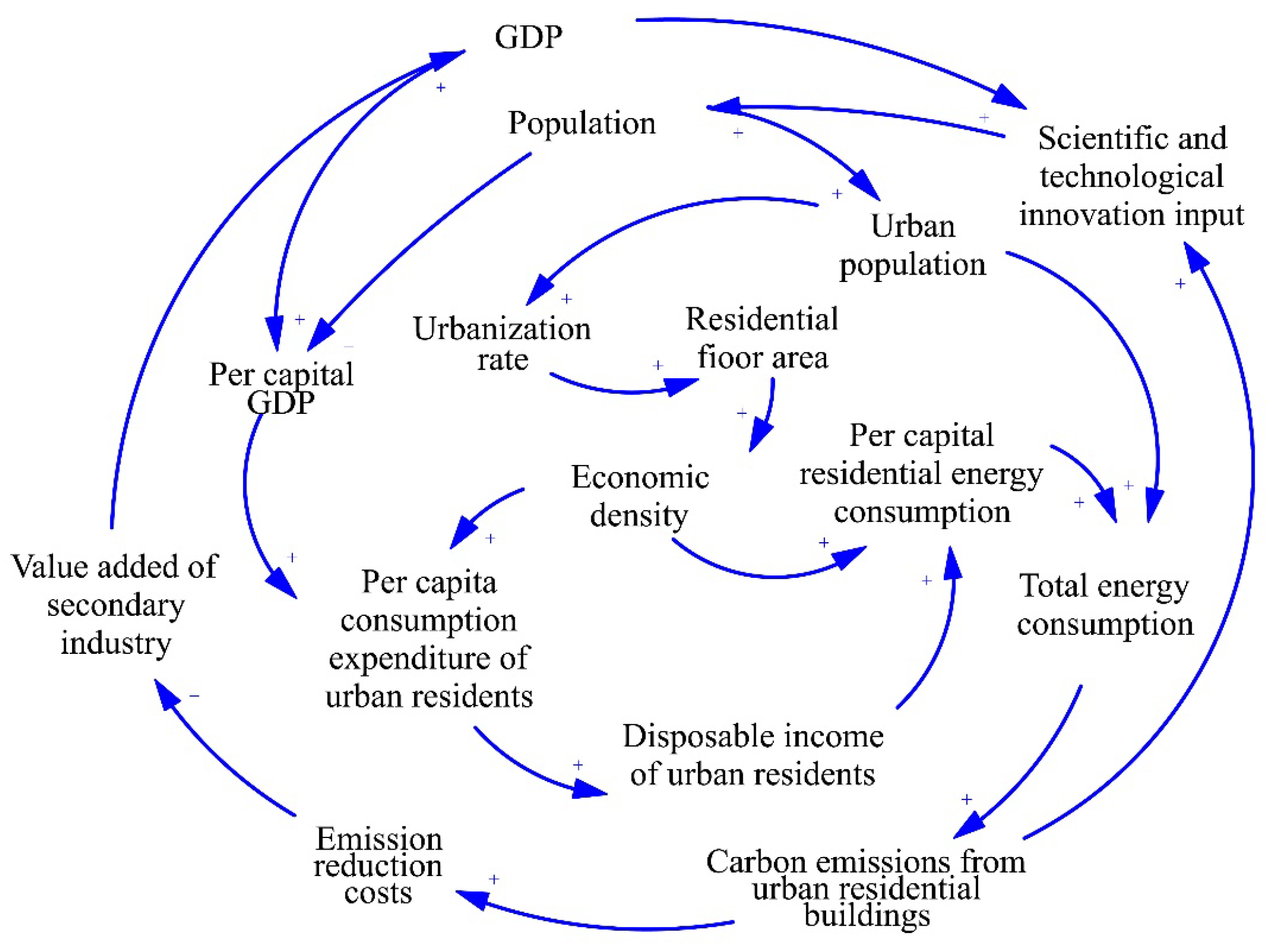

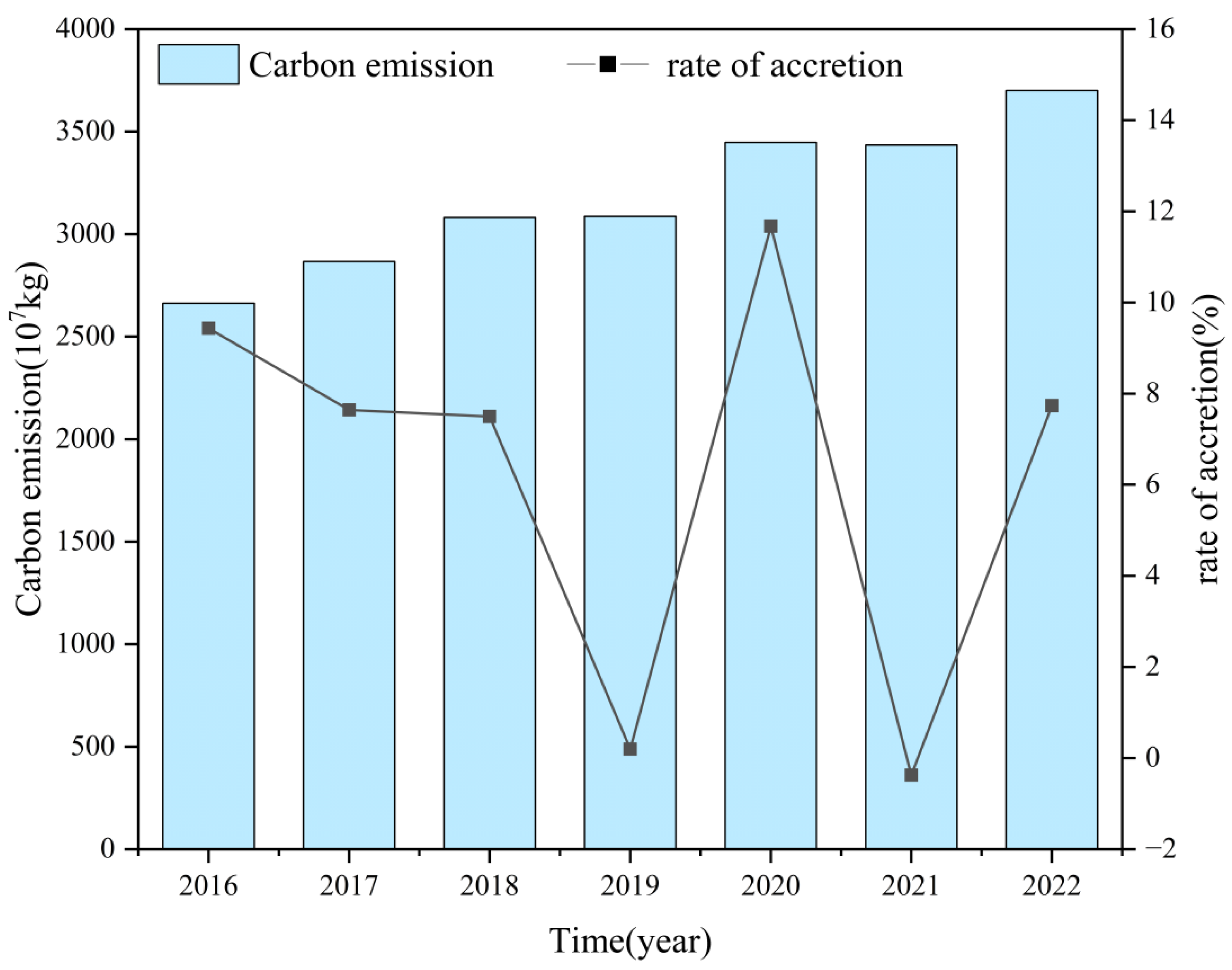
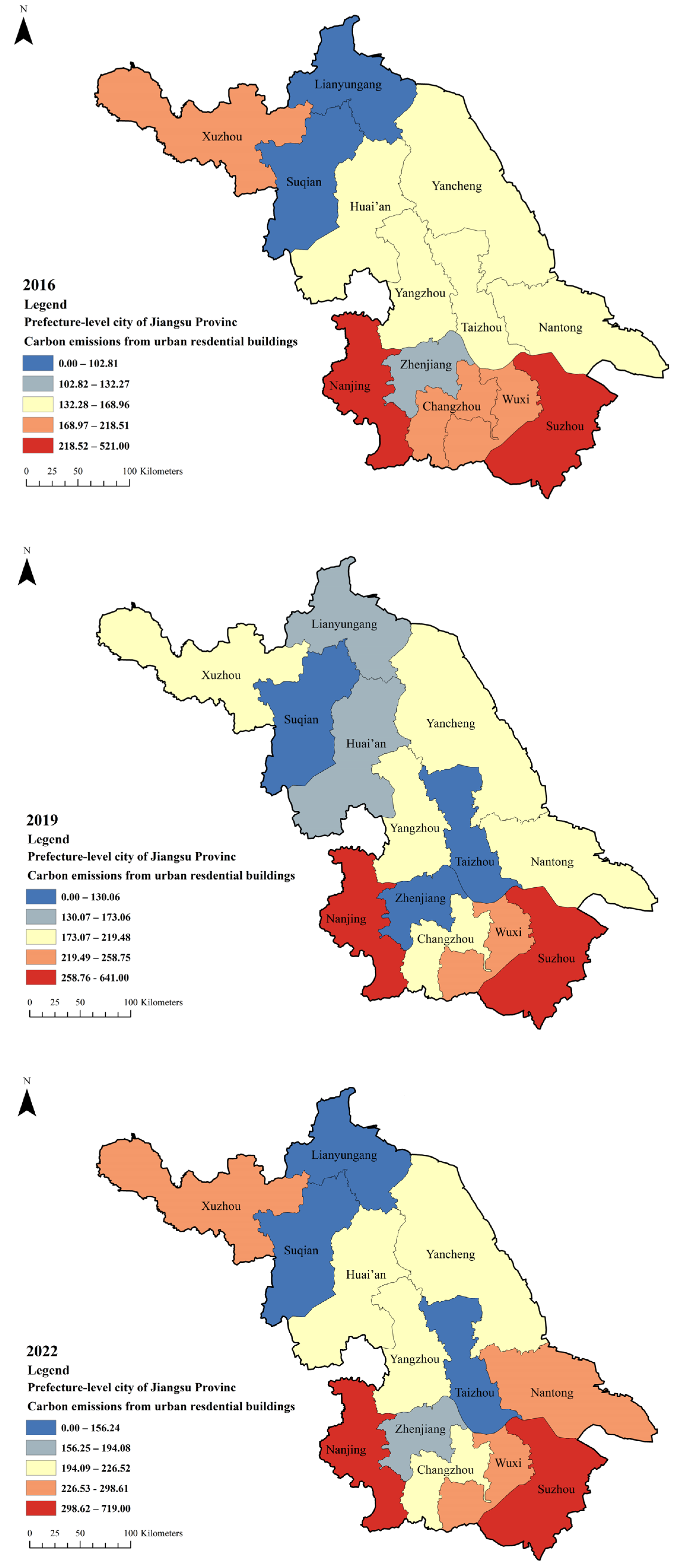
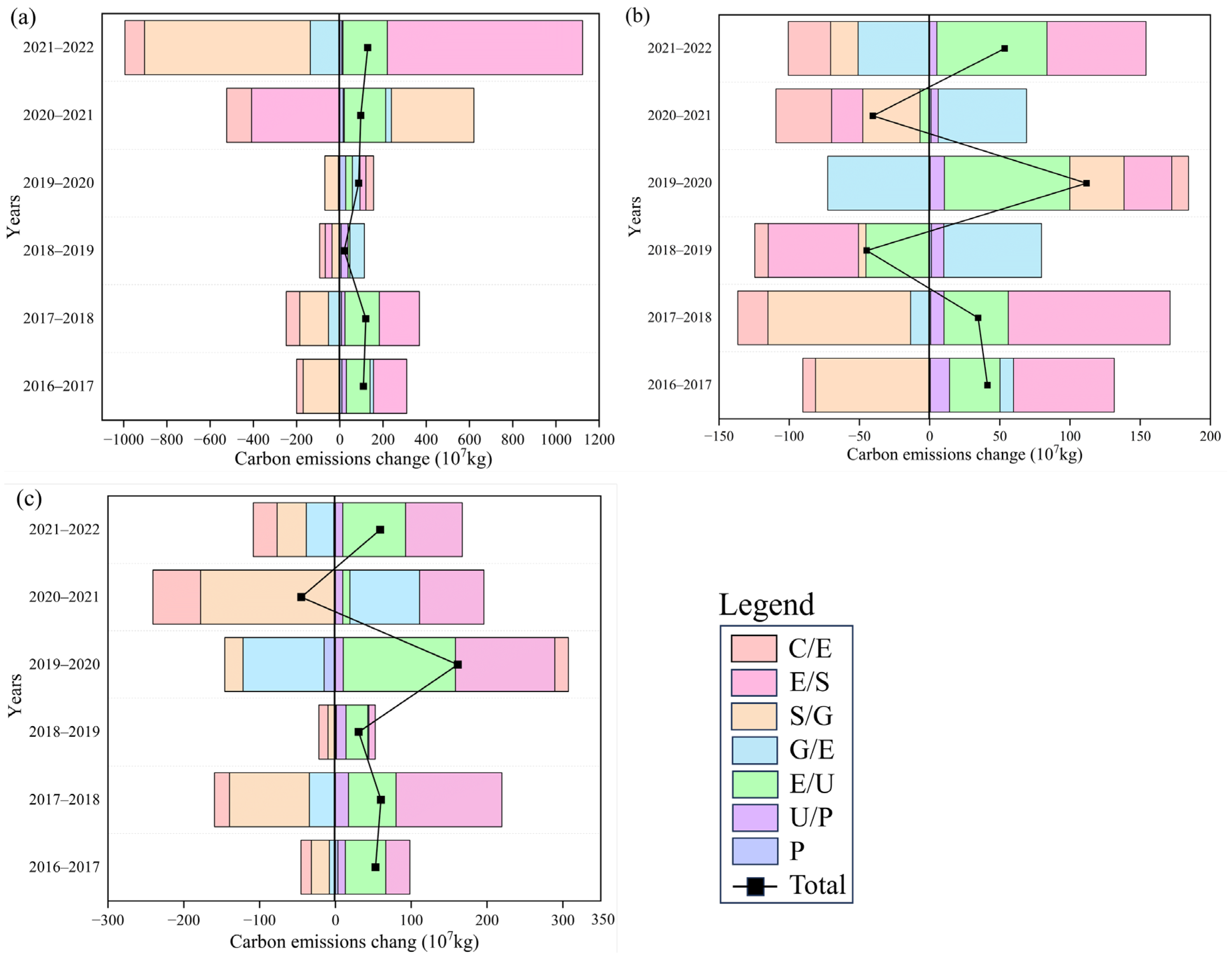
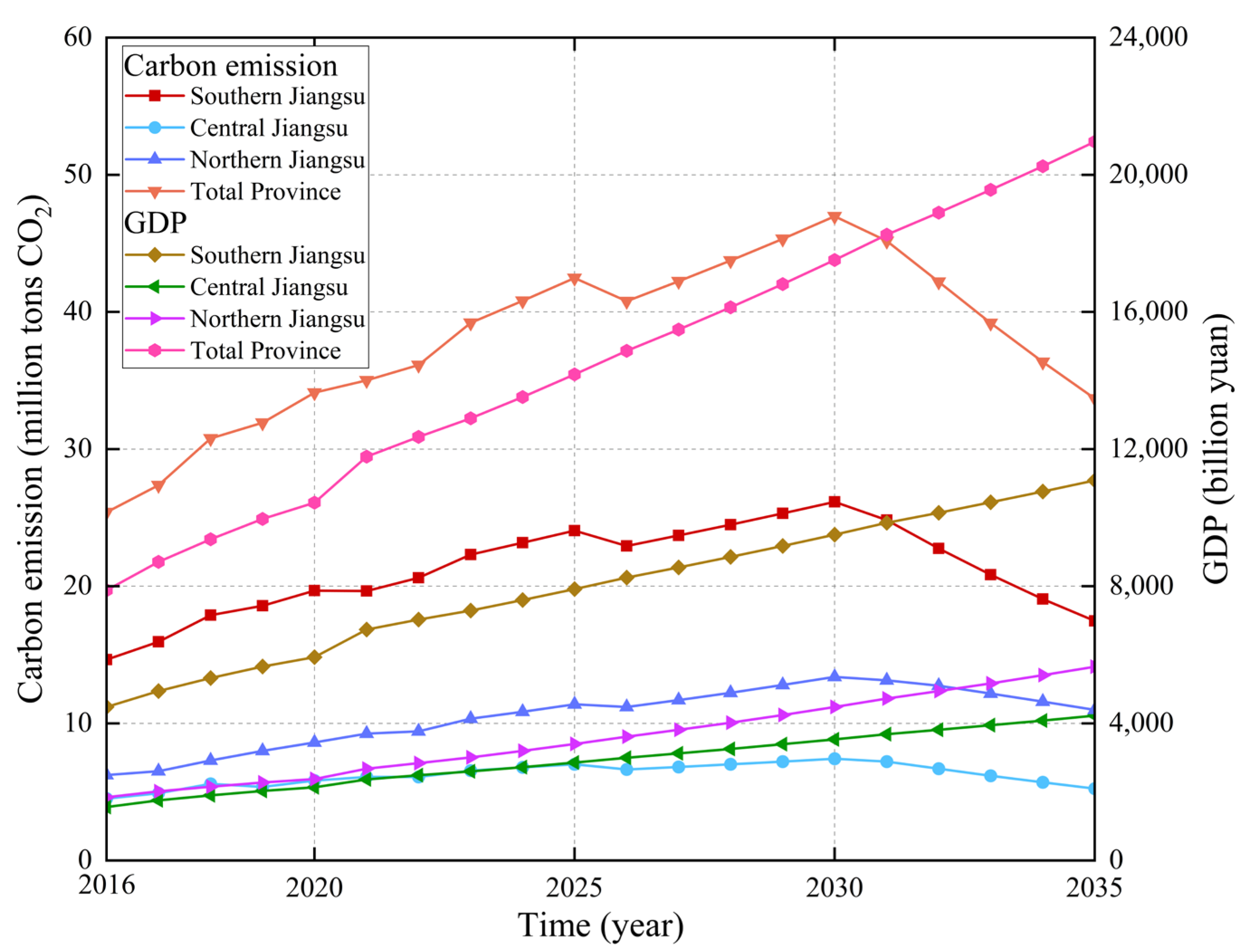
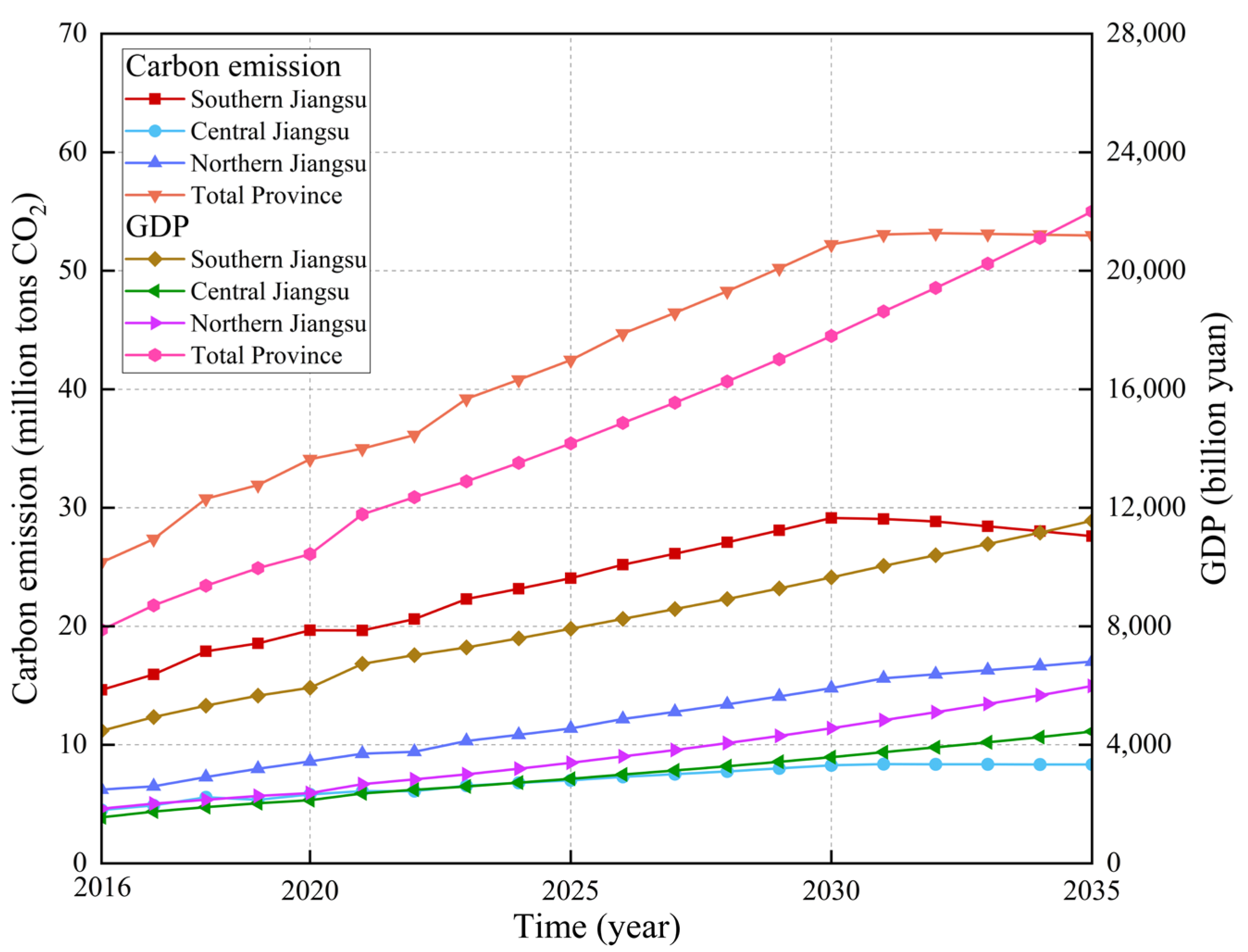
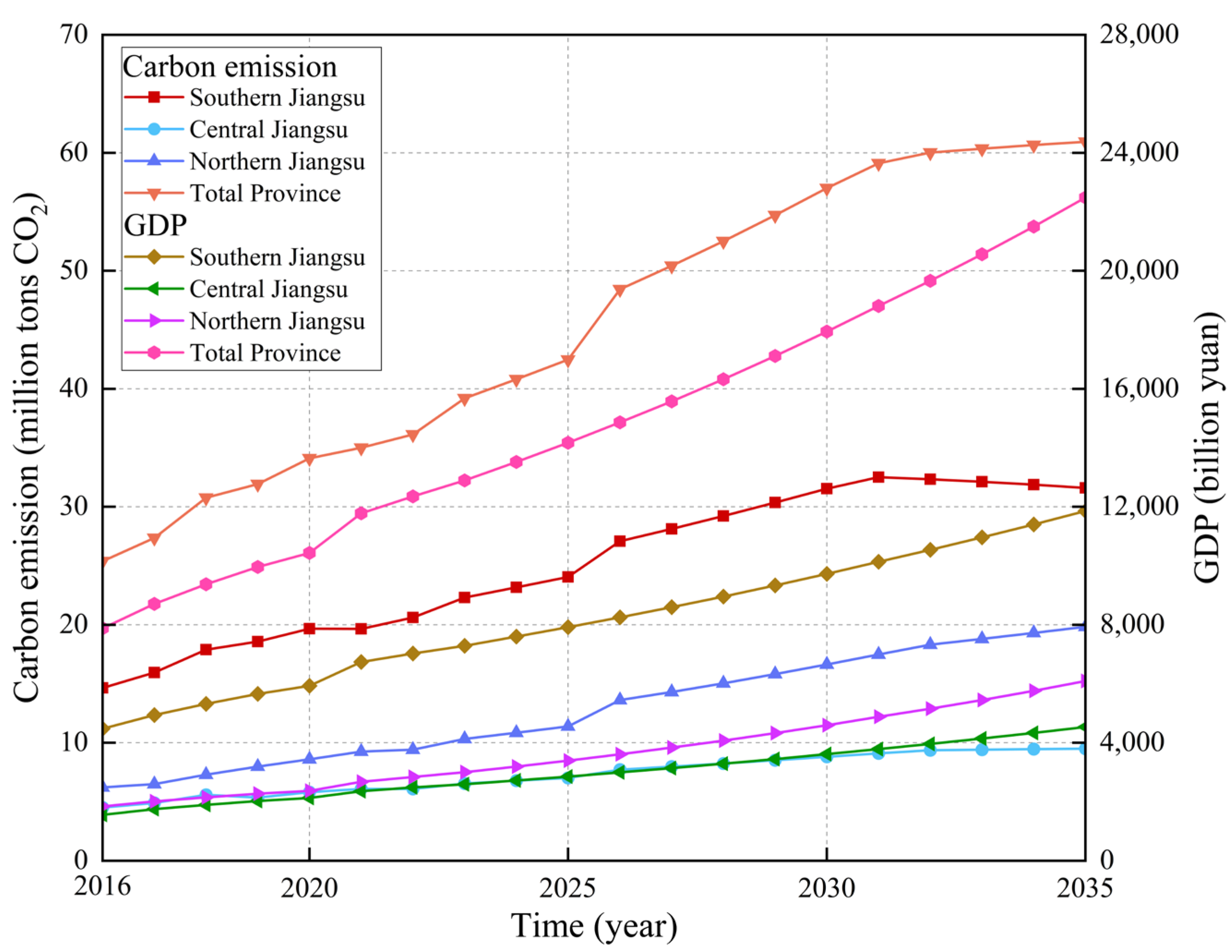
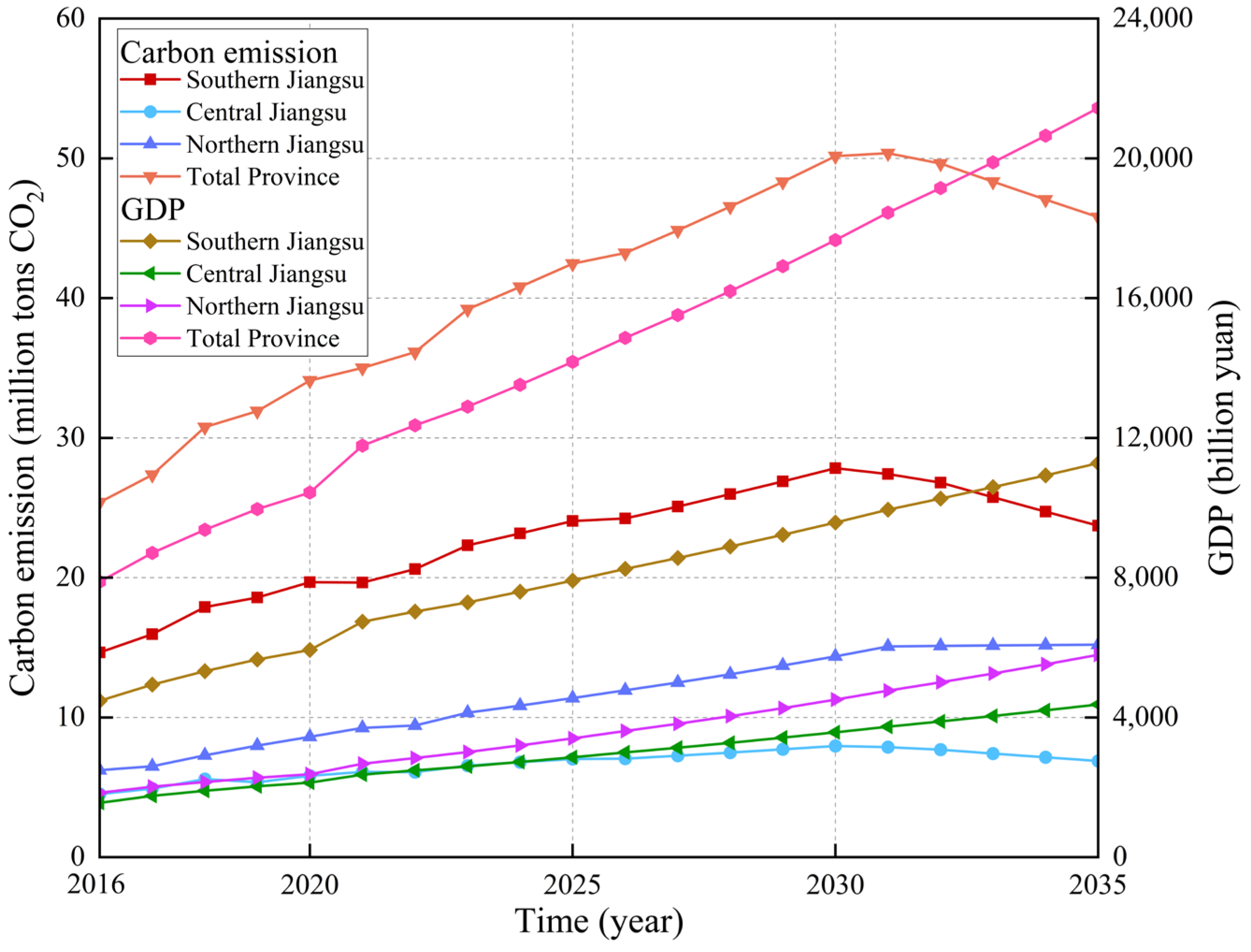
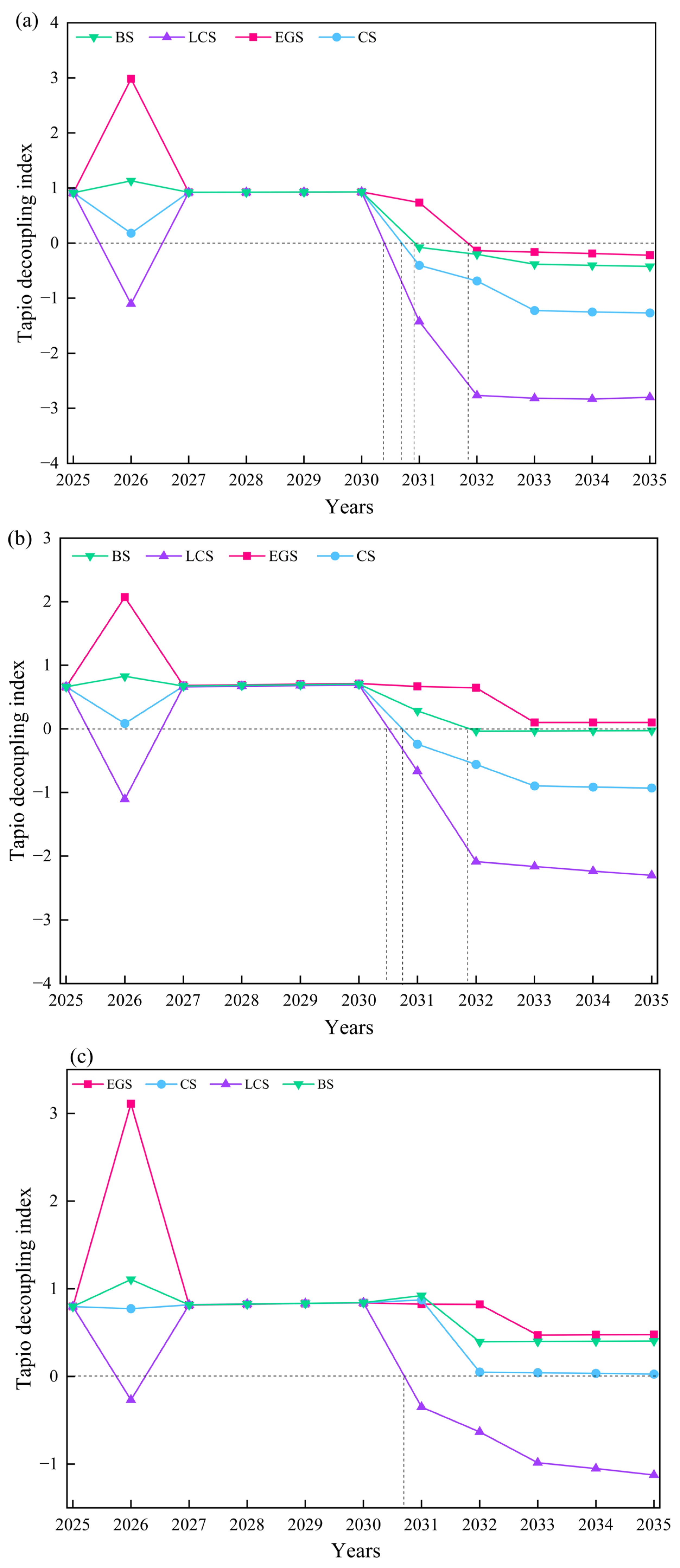
| Decoupling State | ΔC | ΔG | T | Decoupling Type |
|---|---|---|---|---|
| Decoupling | ΔC > 0 | ΔG > 0 | 0 < T < 0.8 | Weak decoupling |
| ΔC < 0 | ΔG > 0 | T < 0 | Strong decoupling | |
| ΔC < 0 | ΔG < 0 | T > 1.2 | Recession decoupling | |
| Negative Decoupling | ΔC < 0 | ΔG < 0 | 0 < T < 0.8 | Weak negative decoupling |
| ΔC > 0 | ΔG < 0 | T < 0 | Strong negative decoupling | |
| ΔC > 0 | ΔG > 0 | T > 1.2 | Negative decoupling of expansion | |
| Connection | ΔC > 0 | ΔG > 0 | 0.8 < T < 1.2 | Expansion connection |
| ΔC < 0 | ΔG < 0 | 0.8 < T < 1.2 | Recession connection |
| Years | Moran’s Index | Z | P |
|---|---|---|---|
| 2016 | 0.143 | 1.687 | 0.046 |
| 2017 | 0.148 | 1.795 | 0.036 |
| 2018 | 0.250 | 1.951 | 0.026 |
| 2019 | 0.756 | 4.068 | 0.000 |
| 2020 | 0.735 | 4.190 | 0.000 |
| 2021 | 0.176 | 1.654 | 0.049 |
| 2022 | 0.070 | 1.151 | 0.125 |
| Factor | Southern Jiangsu | Central Jiangsu | Northern Jiangsu | |||
|---|---|---|---|---|---|---|
| 2016–2022 | Contribution (%) | 2016–2022 | Contribution (%) | 2016–2022 | Contribution (%) | |
| P | 76.11 | 13.52 | 3.96 | 2.54 | −13.89 | −4.36 |
| U/P | 71.83 | 12.76 | 52.27 | 33.56 | 69.39 | 21.76 |
| E/U | 704.58 | 125.2 | 197.39 | 126.74 | 385.36 | 120.84 |
| G/E | −43.85 | −7.79 | 5.02 | 3.22 | −92.19 | −28.91 |
| S/G | −786.85 | −139.82 | −210 | −134.83 | −378.18 | −118.59 |
| E/S | 830.7 | 147.61 | 204.97 | 131.60 | 470.38 | 147.51 |
| C/E | −289.75 | −51.48 | −97.86 | −62.81 | −121.98 | −38.25 |
| Total | 562.77 | 100 | 155.75 | 100 | 318.89 | 100 |
Disclaimer/Publisher’s Note: The statements, opinions and data contained in all publications are solely those of the individual author(s) and contributor(s) and not of MDPI and/or the editor(s). MDPI and/or the editor(s) disclaim responsibility for any injury to people or property resulting from any ideas, methods, instructions or products referred to in the content. |
© 2025 by the authors. Licensee MDPI, Basel, Switzerland. This article is an open access article distributed under the terms and conditions of the Creative Commons Attribution (CC BY) license (https://creativecommons.org/licenses/by/4.0/).
Share and Cite
Xu, J.; Lei, T.; Yang, M.; Xiang, H.; Miao, R.; Zhou, H.; Ma, R.; Ding, W.; Xu, G. Exploration of Carbon Emission Reduction Pathways for Urban Residential Buildings at the Provincial Level: A Case Study of Jiangsu Province. Buildings 2025, 15, 2687. https://doi.org/10.3390/buildings15152687
Xu J, Lei T, Yang M, Xiang H, Miao R, Zhou H, Ma R, Ding W, Xu G. Exploration of Carbon Emission Reduction Pathways for Urban Residential Buildings at the Provincial Level: A Case Study of Jiangsu Province. Buildings. 2025; 15(15):2687. https://doi.org/10.3390/buildings15152687
Chicago/Turabian StyleXu, Jian, Tao Lei, Milun Yang, Huixuan Xiang, Ronge Miao, Huan Zhou, Ruiqu Ma, Wenlei Ding, and Genyu Xu. 2025. "Exploration of Carbon Emission Reduction Pathways for Urban Residential Buildings at the Provincial Level: A Case Study of Jiangsu Province" Buildings 15, no. 15: 2687. https://doi.org/10.3390/buildings15152687
APA StyleXu, J., Lei, T., Yang, M., Xiang, H., Miao, R., Zhou, H., Ma, R., Ding, W., & Xu, G. (2025). Exploration of Carbon Emission Reduction Pathways for Urban Residential Buildings at the Provincial Level: A Case Study of Jiangsu Province. Buildings, 15(15), 2687. https://doi.org/10.3390/buildings15152687







